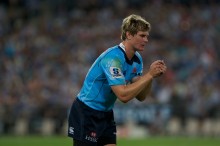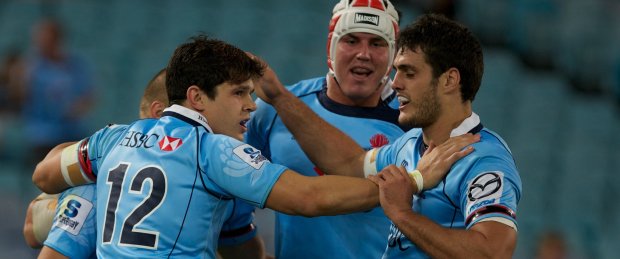In Part 1 I suggested that the way of thinking about the total squad has to change to a more European model to preserve fitness and improve team performance and durability. And a key positional change is needed to cover the loss of Beale. In this part we’ll look at three in-game issues:

1. Playing a much more running/passing game in the backline, with backs close to the advantage line: For simplicity and because I was around in their golden period, I’ll call this the ‘3 Ellas’ mode of backline play. Anyone who saw them will know instantly what I mean. Short passing close to the advantage line, players looping to handle more than once in the one movement; and then when the gap opens (and most times it does) the team is away. It is hard to play but if you play it well it can be almost impossible to defend, because for the defensive side it’s harder to slide till it’s just too late. Gaffney is used to coaching the system well and he needs to resurrect it for the Waratahs as the underlying strategy on which the whole backline attack is built.
This is not (and never was then) a run-it-from-everywhere strategy. Kicking is still an integral part of the gameplan, particularly long kicking for field position (Mitchell’s boot will be useful in that regard). But the kicking has to be purposeful and accurate, not just hoist it when all other options are out. And if you play the ‘3 Ellas’ style it puts the opposition wingers in a terrible quandary – do I sprint up to defend the line or drop back to cover a kick? Choose the wrong one and you can be left stranded.
That has implications for selection. Clearly Carter and Horne are our best centres, but I would put Horne at 12 and Carter at 13 because Horne has the better passing and set-up skills. Carter was not good at 13 in 2010, but this year he played there a number of times and went exceptionally well. That he fits well into the Sydney Uni system at 12 has perhaps blinded people to his skills further out in teams playing different systems. That leaves Turner and AAC as our first-choice wingers. Backup centres are BKH and Kingston, with Pakalani and Trist to back up the wings. Hangers will back up 10 and Foley 15.
2. Looking to dominate and control the game in the forwards: Aah, but I hear you say, this forward phobia is what has been wrong with the Tahs for years. Not so. When the Waratah forwards play well the whole team looks spectacular (think Reds game one and Highlanders in 2011). This was not consistently visible across the season, however, so it is essential for the team to step up their forward attitude. The breakdown has to be won. McCutcheon and Alcock have to improve on 2011 and the rest of the pack has to hit the rucks hard and effectively. The offensive lineout when defending that used to be a key weapon has disappeared and I want it back! The scrum has to improve to be able to counter the Crusaders who were the 2011 competition benchmark.
With Rocky out for the early part of the season, I would play Mumm at 6 and Dennis at 8. Mumm had a poor 2011 but I’m tipping him to bounce back big time. Palu needs to be eased back in from the bench to build up his core fitness and he will be a great impact player off the bench in the first half of the season. If his fitness stands up he can then tear it up in the second half and the finals. Rocky, likewise, needs to be eased back in to let his hamstrings adapt to the pace of the game.
3. Playing the game with URGENCY!: Nothing screams louder to me that a team is on the wrong track than when I see the halfback deliberately hold the ball at the back of the ruck for 15–20 seconds while the rest of the team wanders into position for a series of forward hit-ups. What are the other team doing in this time? Why, setting up their defences ready to repel a new attack. And with modern defensive systems, cracking the defensive line is always tough if the other team tackles well. The solution is to disallow defences the time to reset by playing the game at pace, realigning quickly after a phase and moving the point of attack. It requires a mindset in the halves where playmakers must be ready to go again immediately, where other players step in as soon as one of the playmakers is involved in a ruck, and everything is done at pace. Urgent realignment until the defence is pulled out of position and then a runner hits the hole.
The same urgency needs to be brought to first phase play. The time taken to set up scrums and lineouts is really time for everyone to have a little rest, especially the defending team. Getting there and restarting quickly reduces that advantage, doesn’t allow the other team to set up defensively and puts the attacking team on top.
Playing this way requires three things: players physically capable of meeting the aerobic demands of urgency, a high level of trained fitness and the ability to make decisions quickly and without dithering. In addition to putting pressure on the opposition, it’s also a much better spectacle, which is what the paying fans want to see.
These five things I want to change for 2012. They are not small changes; they require coaches and players to think differently and play differently. But in reality they are part of the Waratah tradition. When the Waratahs teams were at their best over the years these were usually the guiding principles. So it’s sort of a ‘Back to the Future’ solution.

